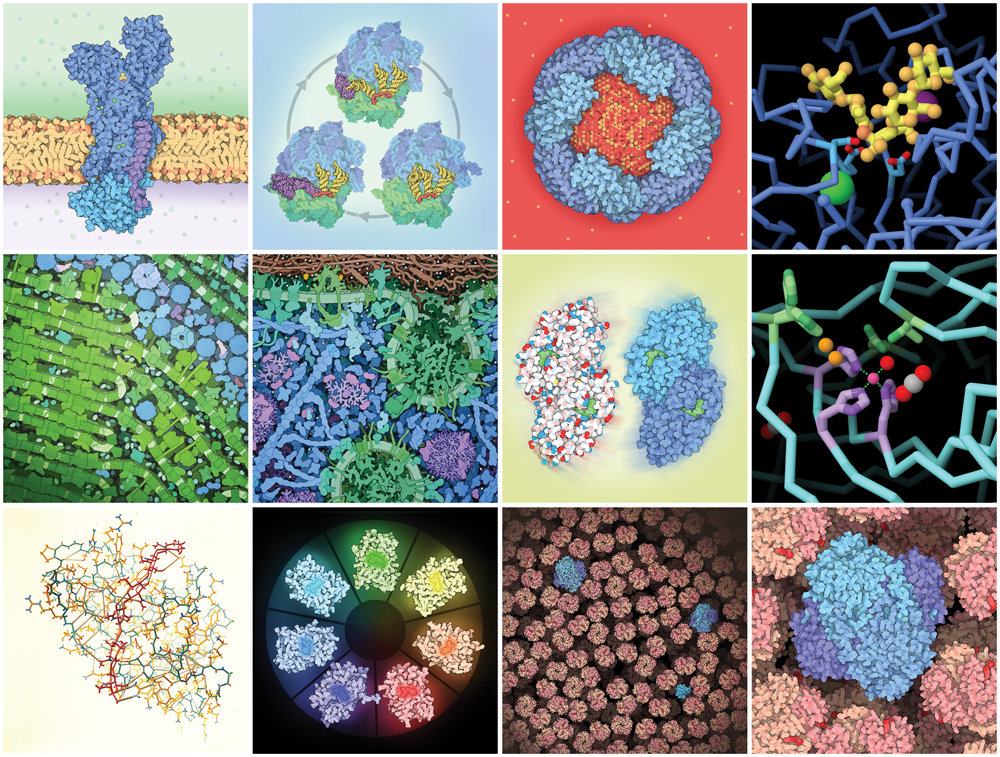Outreach and Education 
Celebrating 20 Years of Molecule of the Month
Since 2000, the RCSB PDB Molecule of the Month series has introduced millions of visitors to the shape and function of the 3D structures archived in the Protein Data Bank.
Created and illustrated by David S. Goodsell (RCSB PDB-Rutgers and The Scripps Research Institute), this feature tells stories about molecular structure and function, their diverse roles within living cells, and the growing connections between biology and nanotechnology. The growth and popularity of the column led to the development of the PDB-101 educational website. Molecule of the Month content has inspired readers around the world, and is a regular read for students and researchers alike. Columns are so compelling that they have been accessed nearly a million times in 2019.
To celebrate this milestone anniversary, Goodsell’s column for January 2020 offers a personal meditation on the growing revolution in structural biology that provides these amazing glimpses into biology. The celebration continues all year long - the 2020 calendar highlights the top-accessed articles year after year, culminating in the highest-ranked articles Hemoglobin and Catalase.
The cover image, which highlights a Cross-Section of the Measles Virus, was selected as a winning entry in the 2019 FASEB BioArt Scientific Image and Video Competition.Protein Science: Special Issue Focused on Tools for Protein Science
Protein Science has devoted another special issue focused on Tools for Protein Science in recognition of the ever‐increasing importance of databases, computational methods, and experimental techniques.
In this issue, the article RCSB Protein Data Bank: Enabling biomedical research and drug discovery demonstrates how publicly available structural data reveal interesting insights into the impact of the three‐dimensional (3D) structures of protein targets important for discovery of new drugs (e.g., G‐protein‐coupled receptors, voltage‐gated ion channels, ligand‐gated ion channels, transporters, and E3 ubiquitin ligases).
The issue features a cover image shown here by RCSB PDB's Maria Voigt that depicts the GLP-1 receptor (blue, PDB structure 5NX2) recognizing a GLP-1 analog (yellow), with liraglutide (green, from PDB structure 4APD) free in solution. The cell membrane is shown in red. Open access to these and related structures in the PDB will facilitate discovery and development of new treatments for diabetes.
Curated Files for 3D Printing
PDB-101 has launched a curated collection of files for 3D printing models of alpha-amylase, ferritin, GFP, and hemoglobin. Each 3D model file highlights a special feature of the molecule and its function. Suggested modeling additions, such as making heme molecules, can help tell a molecular story.
An overview is provided to start to create models for any PDB structure.
Please share any printed models with the team at info@rcsb.org, Facebook, or Twitter.
FASEB BioArt Winner
An image of Measles Virus Proteins from PDB-101's Molecule of the Month was among the 2019 Winners of FASEB's BioArt Competition. This year’s winning graphics represent a wide range of biomedical research, from pink lettuce leaves to a blood clot of a mouse.
Poster Prize at AsCA
At the 16th Conference of the Asian Crystallographic Association, the RCSB PDB Poster Prize went to Ruchika Bhujbalrao for Molecular insights into the mechanism of methyltransferases involved in antibiotic resistance (Ruchika Bhujbalrao Ruchi Anand, IIT Bombay, India). Many thanks to Srinivasulu Aitipamula and the AsCA2019 organizers.




